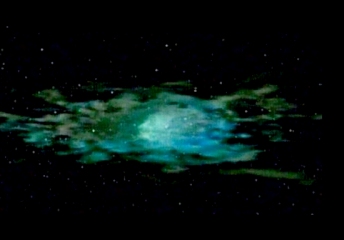|

A distortion ring (also called an spatial distortion
wave, or an implosion ring if it has a spatial implosion component) is
a spatial anomaly where the shape of space-time itself is changing.
In 2371, the USS Voyager was caught by a moving
distortion ring, which collapsed its warp field and enveloped the ship.
Most of the crew were trapped in various sections of the ship, unable
to reach most systems as the spatial distortions continuously
reconfigured the vessel's interior. Based on tricorder data, it seemed
that the ship was also slowly being crushed by a spatial implosion.
Captain Kathryn Janeway was incapacitated after she contacted one of
the spatial distortions.
Lieutenant B'Elanna Torres and Ensign Harry Kim managed
to reach main engineering and initiate a shock pulse, but rather than
dissipating the ring it accelerated the implosion. As the remaining
crew members gathered in holodeck 2, at the center of the ship, the
distortion ring passed through them harmlessly and disappeared. Janeway
regained consciousness shortly after, realizing that the ring was a
lifeform that had been attempting to communicate with her. It was found
that Voyager's entire database had been copied, while 20 million
gigaquads of new information had been downloaded. (VOY: "Twisted")
In real astrophysics, spatial anomalies where the shape
of space-time itself can change have actually been detected around
black holes. The first space-time distortion by black holes was
detected by astronomers in 1997 using NASA's Rossi X-ray Timing
Explorer (RXTE) spacecraft. They observed a black hole that was
literally dragging space and time around itself as it rotates. This
bizarre effect, called "frame dragging," is the first evidence to
support a prediction made in 1918 using Einstein's theory of
relativity. The phenomenon is distorting the orbit of hot, X-ray
emitting gas near the black hole, causing the X-rays to peak at periods
that match the frame-dragging predictions of general relativity.
It is not just black holes that warp space-time. Again,
according to Einstein's general relativity, the Earth warps space-time.
Accordingly, there is a greater change in spin direction, which is now
called the geodetic effect, and also obeys the gyroscope's motion
through the spacetime curvature. The geodetic effect represents the
effect of the curvature of space-time on a spinning, moving body. This
effect was detected in 1988 through lunar ranging and radio
interferometry data gathering. The geodetic effect was verified in 2007
by the Gravity Probe B, an experiment which measures the tilting of the
spin axis of gyroscopes in orbit about the Earth
|
|
